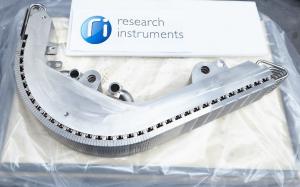Europe launches manufacturing
Tungsten, a shiny, silvery-white refractory metal that has a high melting temperature (3400 °C), will armour these plasma-facing components. For the inner vertical target, the maximum expected temperature on the tungsten surface will be about 1000 °C in normal operating conditions and 2000 °C in off-normal conditions.
During a lengthy manufacturing qualification program, the European Domestic Agency, Fusion for Energy, worked with a number of suppliers to ensure competition and mitigate technical risks through the development of different technologies. After the successful fabrication and testing of small-scale (~1/20th) tungsten monoblock mockups mounted around cooling channel, three companies—the AES Consortium (Ansaldo Nucleare, Ansaldo Energia, and SIMIC), Alsymex, and Research Instruments—were able to qualify full-scale prototypes. Among the most difficult challenges encountered were the procurement of tungsten monoblocks, the bonding of the monoblocks to the copper alloy cooling tubes, the fabrication of the steel support structure, and strict dimensional requirements.
In a major milestone that heralds the start of manufacturing, a first contract has been signed with Research Instruments for the production of 13 inner vertical targets.
See the full story on the Fusion for Energy website.


